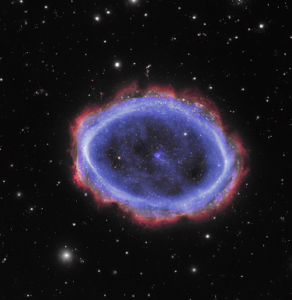How to See The Ring Nebula With a Telescope?

M57 (The Ring Nebula) is a planetary nebula located in the Lyra constellation at a distance of 2,300 light years from the earth. The shell of gas was produced by a red giant that has to evolve away. The expansion rate of this nebula indicates that it is 10,000 years old.
Quick Guide to Observe Ring Nebula
The location and the ideal time to view the Ring Nebula can be determined using a star-gazing program like Stellarium. Discover the Summer Triangle asterism and Vega, the brightest of the trio. The constellation Lyra contains Vega. Locate the Ring using either your finderscope or the Red-dot finder. Form a line with Gamma and Beta Lyrae. In the middle of the line, locate the Ring Nebula. When viewed with a 4-inch telescope at 111x magnification, the Ring Nebula appears as a smoky ring.
Make sure you are using a star app.
You can use a star app like Stellarium to find the location and best time to observe the Ring Nebula.
How to find Ring Nebula?
- Identify the Summer Triangle asterism and find the brightest star of the trio named Vega. Vega belongs to the constellation Lyra.
- Use the Red-dot finder or your finderscope to locate the Ring.
- Join a line along Gamma Lyrae and Beta Lyrae. Find the Ring Nebula midway along the line.
What is the best time to observe the Ring Nebula?
M57 is best seen in only 3 months a year- June, July, and August. But depending on your location, it can appear 15 days earlier. So you can look for it from May 15. The table describes the rise and set time of the Ring Nebula and the best time to observe it.
| Month | Transit | Rise | Set | Notes |
| January | 11:30 | 03:30 | 20:00 | |
| February | 09:30 | 01:30 | 18:00 | |
| March | 08:30 | 23:30 | 17:00 | |
| April | 06:30 | 22:30 | 15:00 | |
| May | 04:30 | 20:30 | 13:00 | Best after midnight |
| June | 02:30 | 18:30 | 11:00 | Visible all night |
| July | 00:30 | 16:30 | 09:00 | Visible all night |
| August | 22:30 | 14:30 | 07:00 | Visible all night |
| September | 20:30 | 12:30 | 05:00 | Best before midnight |
| October | 18:30 | 10:30 | 03:00 | |
| November | 15:30 | 07:30 | 00:00 | |
| December | 13:30 | 05:30 | 22:00 | Not observable |
4 Tips to observe Ring Nebula in the best way.
- Choose a clear night.
- A narrowband or OIII filter will enhance the contrast.
- Ring Nebula is small, so do not expect to get a larger view.
- Use low magnification at first to spot it.
What can you see with the Ring Nebula?
- With a 4-inch telescope and 111x magnification, the Ring Nebula looks like a smoky ring.
- Just east of the ring, you will see a 13-th magnitude field star.
- With a 10-inch telescope you will get an incredible view of the Ring Nebula with its natural color. You will find the northwest and southeast edges brighter than the rest of the ring. You will also find that the center is not completely dark, it is somewhat glazed.
- A 10-inch telescope will show you a faint star with a magnitude of 14 at the southeast of the 13-magnitude star.
What telescope to see Ring Nebula?
Celestron Starsense Explorer 10″ Dobsonian, Sky-Watcher 12″ f/3.93 Quattro Imaging Newtonian, and Meade 16 LX 600 ACF f/ 8 are great telescopes to see the Ring Nebula. A list of telescopes to see Ring Nebula has more telescope options that can see Ring Nebula very clearly.
What size telescope to see Ring Nebula?
A 6-inch telescope is enough to see the Ring Nebula. But by using 10-inch telescopes with at least 1000mm of focal length, you will get amazing views with sharp contrast and also see the nearby stars with it.
What magnification is required to observe the Ring Nebula?
The magnification of the telescope to observe the Ring Nebula should be at least 75x-100x. If the telescope allows more magnification, you can use that to get better views. 100x-400x magnification with a 10-14 inch aperture will allow you to sense the colors of the Ring Nebula.
Enjoying the Ring Nebula? Here are other things to see with your telescope.
Ring Nebula is one of a myriad of nebulae you can see with your telescope. Viewing Nebula Through A Telescope can guide you to choose and view other nebulae. Moreover, you will find the planets of our solar system, their moons, and floating asteroids with even a small telescope. Our nearby galaxy Andromeda and other star clusters also appear with a great view. You may go through the ‘List of things to see with a telescope’ to get a shortlist of several night sky objects you can observe with different telescopes.
